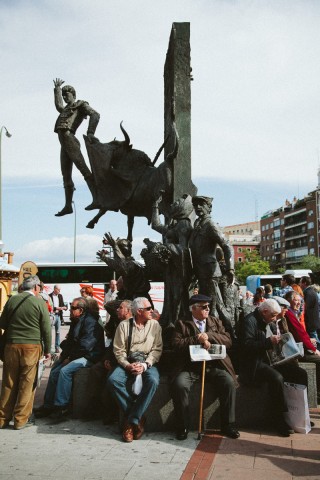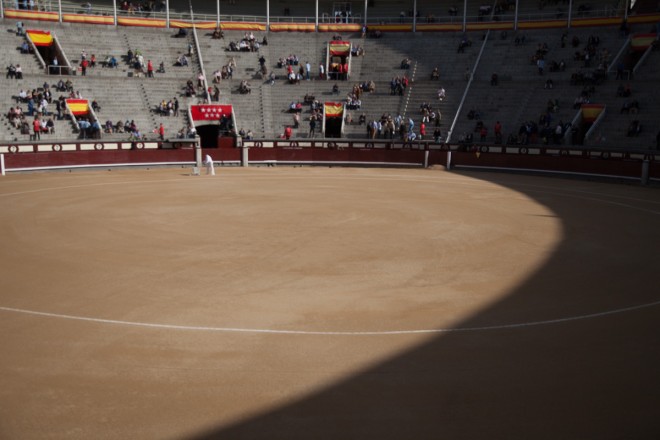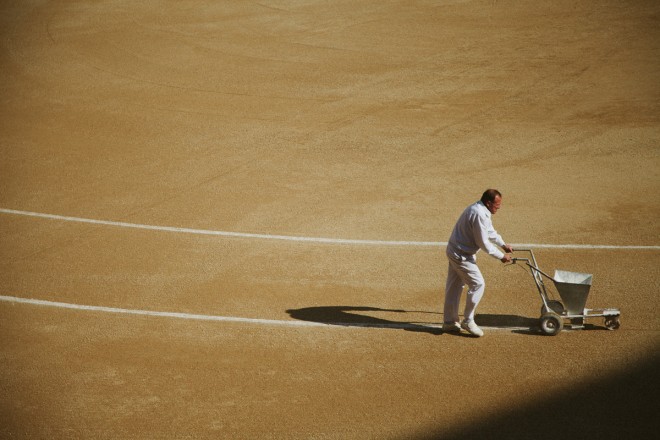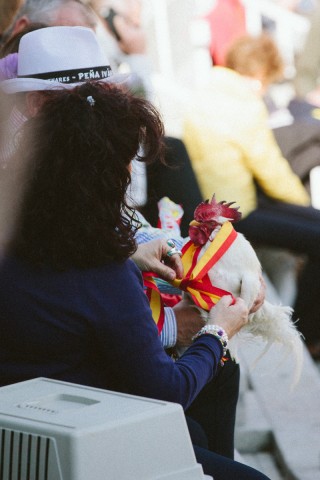At the edge of his seat. Image courtesy of Sruthi Vijayan.
At first glance, the buzz outside Las Ventas seems typical of a large sporting event: the spattering of law enforcement officials, overpriced sodas laid over iceboxes, and cameras mounted on giant orange cranes.
However, if you look close enough, you will not see team jerseys or monogrammed caps, not even frenzied fans in facepaint carrying giant foam fingers.
That’s not to say that there aren’t any sides here. On the contrary, there couldn’t be a clearer distinction. Even the cheapest tickets or the farthest seats won’t lead you to mix-up a Henry for a Diego. There are, as it has always been, only two distinct sides here: man and animal.
I walk through the large iron gates.
The Plaza de Toros de Las Ventas is Madrid’s most famous bullring, often considered home to Spanish bullfighting. Its large brick edifice with multiple arches is encrusted with azure ceramic tiles. The gathering outside is reminiscent of Monday afternoons at leafy parks: grandfathers with grandsons, senior citizens in suits peering at minuscule newsprint.

The Plaza de Toros de Las Ventas was built in 1929 in the Salamanca area in Madrid. The neo-Moorish structure has a capacity of 25,000. Image courtesy of Sruthi Vijayan.

During the off-season, the arena doubles as a music venue, hosting musical artists like Kylie Minogue and Coldplay. Image courtesy of Sruthi Vijayan.

A statue of a torero and a bull outside the bullring. Image courtesy of Sruthi Vijayan.
I walk through the large iron gates. The circular alley that leads to the bullring is filled with voluble chatter and beer. I pay two euros for a seat cushion that doesn’t feel cushiony at all.
I’m early, but the seats are already half-filled. The four o’ clock sun casts a crescent-shaped shadow across the stadium. The most expensive tickets are the ones in the shade; the least expensive are the ones that bare you to the sizzling summer sun. Either way, tickets during this time sell quickly; the San Isidro festival brings the fiercest toreros (bullfighters) across Spain to face-off against the deadliest breed of bulls.

The seats in the stadium are divided into three categories: Sol, Sombra, and Sol y Sombra (Sun, Shade, and Sun and Shade). The seats in the shade are most coveted and can cost up to 150 euros. The least expensive Sol seats can be snagged for 20 euros. Image courtesy of Sruthi Vijayan.

A man draws chalk lines, demarcating the area of fight. Image courtesy of Sruthi Vijayan.

A spectator at the arena. Image courtesy of Sruthi Vijayan.
I pass a middle-aged woman who holds a rooster in her hands. She ties a ribbon bearing the colours of the Spanish flag around its neck. I find my seat; it’s a hard block of concrete that ignites my enthusiasm for the two-euro seat cushion. The gentlemen around me light their fat cigars and gesture heavily.

Spectators at the arena. Image courtesy of Sruthi Vijayan.

The arena is divided into 10 tendidos that roughly make up a group of 27 rows around the bullring that has a circumference of 60 metres. They are then divided into filas (rows). Image courtesy of Sruthi Vijayan.
The bull is released.
The blowing bugle signals the start of a procession of the toreros. Two things stand out in the procession: There is more fuchsia than I anticipated, and toreros wear seriously tight pants. If this were a beauty pageant, the matadors would be the undeniable queens of the ball. The three matadors are the leaders of this entourage; their costumes, called “suits of light” in Spanish are the only ones embroidered with intricate gold threadwork.
The second trumpet signals the beginning of the Corrida (bullfight). The bull is released onto the ring. Like a child at the sound of the last bell on the final day of school, the bull runs hurriedly out of the gates before slowing down right in the middle of the ring. He doesn’t seem angry, just restless and confused.
Then, it begins.
The act of bullfighting itself is divided into three parts.

A picador and a banderillero await the start of the bullfight. The banderillero holds a fuchsia and yellow capote (cape). The picador’s lance is called the vara. Image courtesy of Sruthi Vijayan.
The matador first weighs the bull as banderilleros confront it with a capote (cape). He studies the character of the bull – the turns of its head and obvious tendencies that could be useful.
Then the picadores, armed with lances, enter the ring. They ride on blindfolded horses with heavy pads on the sides that protect the animals from any injury by the bull. The picadores attempt to weaken the neck muscles of the bull by piercing the lance through its back.
Then the banderilleros return with sharp barbed sticks called banderillas. They further attempt to destabilise the animal by spearing the sticks on to its spine.
The last act is called the tercio de muerte (the act of death). The matador enters the ring solo, his muleta (red cape) in hand. He will perform the dance of the capes – indulging the audience in several passes (tandas) before finally placing the sword (stealthily hidden behind his cape) into the back of the bull.

The matador exhibits his muleta to the crowd before he begins the corrida. Image courtesy of Sruthi Vijayan.
The first 10 minutes are the hardest to watch: The first piercing stroke, the smearing blood on the sandy floor. The raven hair of the bull does not subdue the intensity of the blood that soaks it. This is the moment that separates the tourists from the patrons – while most first-time viewers are forced into a flinch, patrons yell “Ole!” to cheer the matador for a pass well done.
As the evening progresses, one thing becomes abundantly clear: The bull seems like the real hero, the underdog who doesn’t own a shiny costume or have legions of cheering fans. Yet, he fights.
He remains strong.
By the third act, the animal is either tired, angry, or both. The matador then enters, swishing his fiery muleta. His form stays rigid, while his movements resonate fluidity. These moments are the ones pro-corrida groups often refer to in defence of bullfighting. It’s not a sport, they say, it’s a tradition of the brave, courageous, and skilled. Back erect, chest out, toes pointed outwards, the matador’s arms are stretched like the hour hand at three. If there wasn’t blood, gore, sharp objects, or ultimate death, this could be a ballet recital.
There are moments of intense fear that grip me, like when the matador turns away from a snorting bull to rake in applause. I want to holler across the ring, begging him not to be so smug, that if we’ve learnt anything from the movies, it’s that bad things happen to the cocky ones. But that’s a part of the game – his surrendering of fear is what elevates him from those across the barricades.
He remains strong. These are instants that are captivating, solely because the mind rarely sees the body react to danger with such uncharacteristic defiance.
But the inevitability of how this will end smears the moment for me — there’s no poetry in a gruesome end that cannot be altered. As the crowd awaits the penultimate swing of the sword, the narrative stumbles. The matador slips and is gored in the stomach, all in an instant. He rolls over in pain. There is sudden commotion, but the torero wants to go again. He limps back to the ring before falling again. He’s carried away on a stretcher. Matador number three enters and finishes the job.
There’s a frenzied waving of white handkerchiefs. I assume it is peace. I’m told that the waving is a sign from the audience imploring the president to award the ear of the bull to a young banderillero. It is custom to reward exemplary performances with the chopped ear of the slaughtered bull.
The banderillero marches across the arena, ear in hand. The night comes to an end. Another day in the ring — a new star rises, an old one faltered, and the bull – well, he never wins, even if he does.
